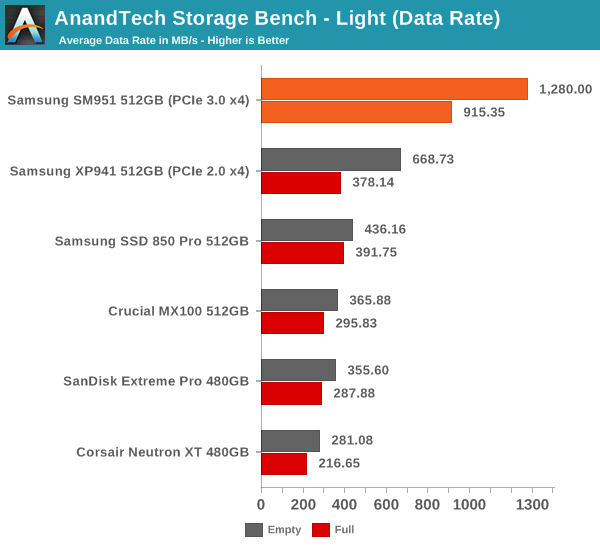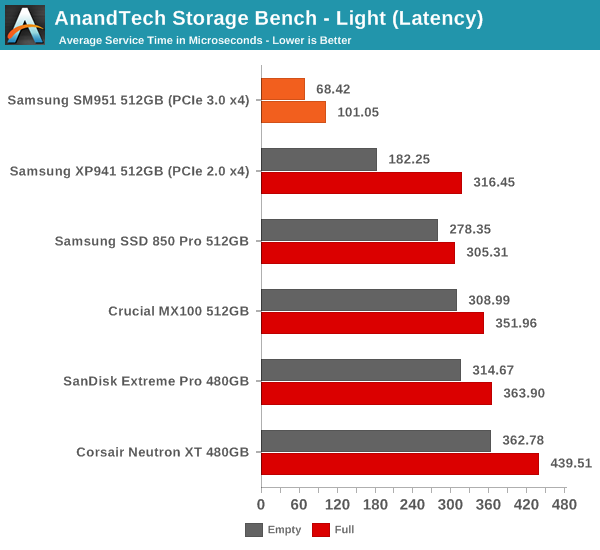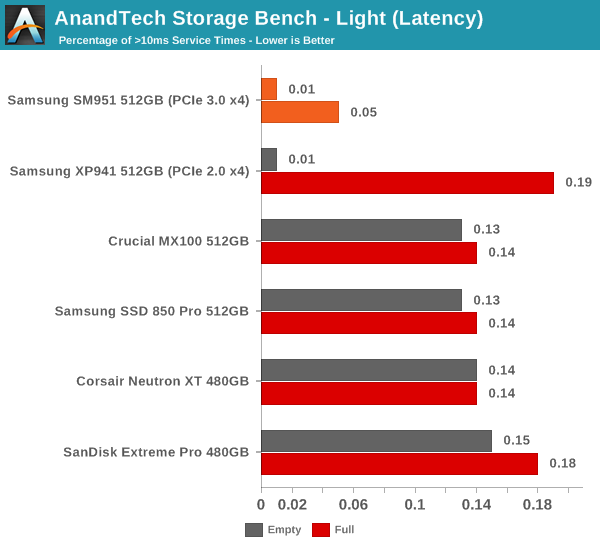Samsung SM951 (512GB) PCIe SSD Review
by Kristian Vättö on February 24, 2015 8:00 AM ESTAnandTech Storage Bench - Light
The Light trace is designed to be an accurate illustration of basic usage. It's basically a subset of the Heavy trace, but we've left out some workloads to reduce the writes and make it more read intensive in general.
| AnandTech Storage Bench - Light - Specs | ||||||||||||
| Reads | 372,630 | |||||||||||
| Writes | 459,709 | |||||||||||
| Total IO Operations | 832,339 | |||||||||||
| Total GB Read | 17.97 GB | |||||||||||
| Total GB Written | 23.25 GB | |||||||||||
| Average Queue Depth | ~4.6 | |||||||||||
| Focus | Basic, light IO usage | |||||||||||
The Light trace still has more writes than reads, but a very light workload would be even more read-centric (think web browsing, document editing, etc). It has about 23GB of writes, which would account for roughly two or three days of average usage (i.e. 7-11GB per day).
| AnandTech Storage Bench - Light - IO Breakdown | |||||||||||
| IO Size | <4KB | 4KB | 8KB | 16KB | 32KB | 64KB | 128KB | ||||
| % of Total | 6.2% | 27.6% | 2.4% | 8.0% | 6.5% | 4.8% | 26.4% | ||||
The IO distribution of the Light trace is very similar to the Heavy trace with slightly more IOs being 128KB. About 70% of the IOs are sequential, though, so that is a major difference compared to the Heavy trace.
| AnandTech Storage Bench - Light - QD Breakdown | ||||||||||||
| Queue Depth | 1 | 2 | 3 | 4-5 | 6-10 | 11-20 | 21-32 | >32 | ||||
| % of Total | 73.4% | 16.8% | 2.6% | 2.3% | 3.1% | 1.5% | 0.2% | 0.2% | ||||
Over 90% of the IOs have a queue depth of one or two, which further proves the importance of low queue depth performance.

The SM951 yet again provides roughly twice the data rate compared to the XP941 and with a full drive the difference is even more significant.

The same goes for average latency where the SM951's score is about one third of the XP941's. The SM951 can without a doubt boost performance with lighter IO loads as well, although in very light workloads the bottleneck tends to be the speed of user input (think about document creation for instance).











128 Comments
View All Comments
Kristian Vättö - Sunday, March 1, 2015 - link
The 840 EVO issue takes weeks, even months to show up, so testing it is not something that we can really incorporate in our test suite.The read speed depends on the test you use and its specifications. The figures are always "up to" and tend to be based on high queue depth 128KB sequential read performance. You may want to try multiple benchmarking apps, but especially ATTO tends to show high performance since it tests multiple IO sizes.
And yes, we run the SSD as a secondary drive to eliminate any OS overhead.
MFinn3333 - Saturday, February 28, 2015 - link
Is there any way you can review the Fujitsu FSX 240GB? It's an old drive but it is the only consumer level drive that I am aware of that uses entirely SLC?Kristian Vättö - Sunday, March 1, 2015 - link
At least for now it's not in the review queue, but I will keep it in mind in case I have excess time.kenshinco - Monday, March 2, 2015 - link
How can we get the sm951 to runs up to the rated speed? The rated speed for 512gb is 2.15gbs/1550mbs read/write, but i got only 1560mbs/1570mbs read/write. I got temp monitor never pass 75 when testing.Kristian Vättö - Monday, March 2, 2015 - link
I was able to achieve 2250MB/s with 128KB sequential read (QD32) on an empty drive, which is how the read performance has been rated. That's not a realistic bench, though, because in reality you will never be reading from an empty drive.Gonemad - Thursday, March 5, 2015 - link
No word on Novachips 8TB SSD yet?http://www.theregister.co.uk/2015/03/05/eight_tera...
CallsignVega - Friday, March 6, 2015 - link
I just purchased the SM951 from the UK (512GB for $450). They are out there, you just have to know where to look.vegipiniata - Wednesday, March 11, 2015 - link
I got one SM951 512GB for 340£They were gone later that day.
Have Z97 Extreme9 and can't set it as the boot drive though :(
Bios 1.3 from DEC 2014
any chance it's the BIOS fault (too old)?
Stas - Friday, March 13, 2015 - link
There we go. Finally an incentive to upgrade from 2500k to a new platform. Once mobos with M.2 and NVM hit the market in Summer/Fall, I will be retiring the faithful rig.Edgar_in_Indy - Friday, March 13, 2015 - link
The 2500k is too good to retire!When I upgraded my main system a few weeks ago, I recycled my old 2500k and the board for use in a living room HTPC build that can handle 4K video files and do some gaming, all while running Windows Media Center with 5 ATSC tuners.